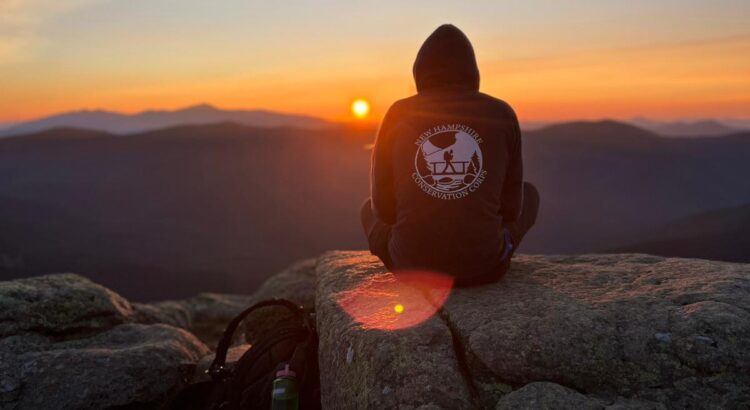A look into SCA New Hampshire Field Crew
By Andrew Kniska, SCA Interpretive Ranger
I was able to catch up with three members of the SCA New Hampshire Trail crew, Mel, Dante and Rachel. They taught me a lot about what they do as a trail crew member and why they do it.
Firstly, trail crew are people who do any sort of trail work. This can range from clearing the trails and of fallen trees, blazing new trails, building whole bridges and shelters, and so much more. If you have been on a trail or stayed at a backcountry campsite, you can thank the trail crew for that. They do this work on 11-day journeys called hitches. Hitches consist of 5-6 people, and during this time, they can expect to be camping or in backcountry conditions with limited showers and little internet. Our SCA Trail Crew members have the option to choose between rigging, working with ropes, and chainsaw training. SCA Field Crew members Dante and Rachel took rigging training while Mel took chainsaw training. Rigging can be used for moving timber and large stones that can weigh up to 1000 pounds! Meanwhile, chainsaws work on the hazardous job of cutting trees and carpentry.
“Here, Mel and Brenda remove a blowdown tree from blocking the trail- we call this corridor clearing. That can be with chainsaws and loppers or handsaws to remove anything in the way of the trail or anything that might grow to get in the way of the trail”
– Rachel Hidding, SCA Field Crew
Challenges that come with the job can include the chainsaws, heavy objects in the air, as well as weather, miscommunication, and anything that comes with being outdoors. The SCA does a great deal to minimize these risks, from proper training, PPE, and risk assessment plans done for every project, our field crew members feel safe doing their job.
“These are some photos of us building Adirondack shelters at Pillsbury State Park… they later got walls too! These shelters are nice for groups when camping- providing a place to hang out outside of inclement weather”
– Rachel Hidding, SCA Field CrewOur field crew have learned so much while working here, especially with camping and preparedness. “I’d have to say my general camping and hiking skills have taken a huge leap.” says Dante “Things like how to efficiently set up or what kind of foods to bring.” Rachel added
“It’s interesting to see what becomes important to you when you’re out camping for 11 days at a time… making sure meals are well distributed to prevent food waste- for when we’re out on a project and don’t have access to a fridge”. She says she “feel[s] more in tune with nature now as well- noticing all the little bugs and creatures flying and crawling around. It’s a privilege to be so close to nature all the time and get to experience all the marvels that brings- pink sunsets with bats swooping by, beavers popping their head in and out of a lake, a slow moving little snail” Mel said that he has developed “strong leadership and greater awareness of the feelings and thoughts of others”.
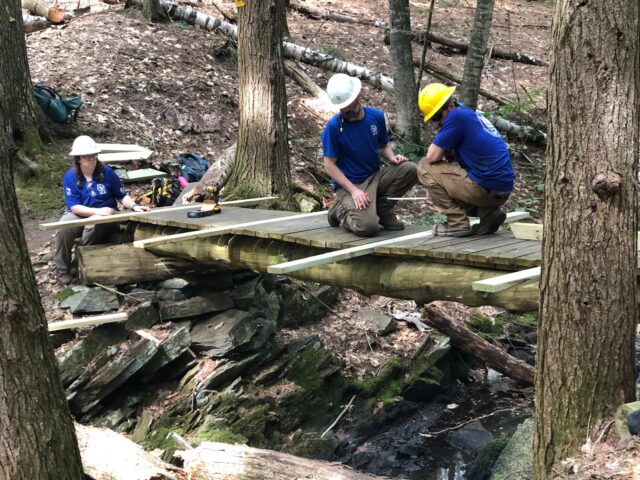
Photo by Dante Giampaolo
Everyone has a different reason as to why they took on this job, but a throughline is a love of nature. Dante told me that he’s “a lifelong hiker and grew up in the area so being able to make an impact on trails and parks I know seemed really fulfilling and fun.” Rachel said she took this job because she “love[s] being outdoors, challenging myself, and exploring new places. I had never been to New England before coming to work with SCA and I’ve been loving exploring the natural areas of New Hampshire” Finally, Mel added that “my desire to help others and the world “ is what inspired him to join up.
These are “Retaining walls and stairs. Both can be made of rock or wood. Retaining walls act to keep soil in place on a steep side of the trail. They’re a way to prevent erosion caused by both water and human use. We build stairs on trails to make them safer for users (better to walk on a consistent level incline) and also encourage people to follow the trail and not walk in areas with sensitive plant life!”
-Rachel Hidding, SCA Field CrewPhoto by Rachel Hidding
While on harder trails, one big rock in the mountain, uncut and smooth, may be a tough obstacle for hikers. This being a difficult and dangerous part of the trail, and I asked field crew why they might not be able to cut into the rock to make things easier.
Cutting into rock isn’t something that field crew will typically do. They may be able to build ladders or reroute to an easier way up. However, making a stone staircase needs a lot of tools and effort put into them. A rock drill, generator, power cords, feathers and wedges take a lot of energy to bring up a long way, and it may not be feasible for field crew to do work on these features. Mel added that he would like to incorporate gargoyles.
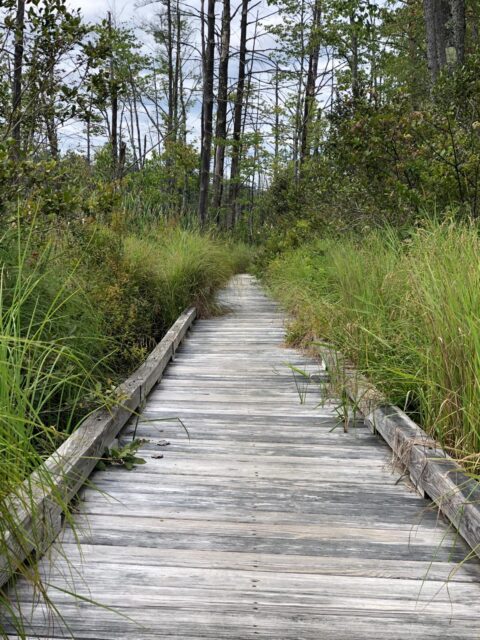
Photo by Dante Giampaolo
It is always best to stay on trails. However, sometimes hikers will lose the path and have to bushwack off trail to get to another trail. Whether it be confusion, lack of use, or poor design, people can get off track. So I asked for advice on staying on the trail from the people who make them, and here is what they had to say. They told me a few helpful things. Firstly, take a minute to orientate yourself. Pause and look around. Looks for signs of a trail like beaten down leaves and visible dirt, or a break in the canopy above. Trail markers are typically in white, yellow, or orange. Look for these markings. Bring a physical map with you alongside downloading one onto your phone. Finally, if it is far too difficult to follow, consider turning back around.
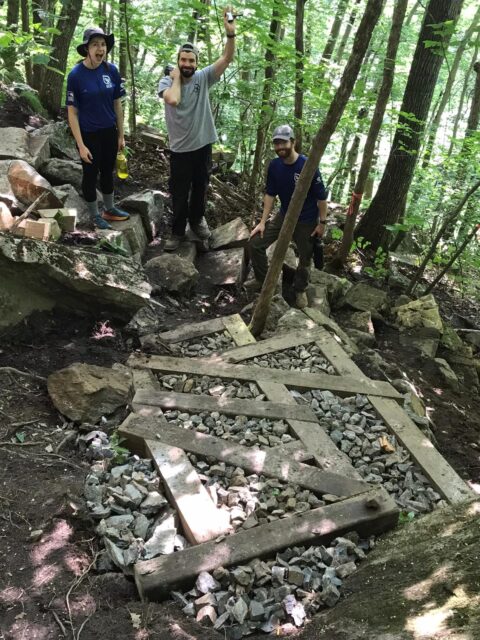
Finally, our trail crew members have a special message for you, the park visitor.
“I only want them to know to appreciate nature and respect the work put in by limiting their own impacts on the park. I haven’t seen too much of it but leaving trash (Especially dog poop bags!!) and going off trail can really negatively impact the park.” -Dante Giampaolo, SCA Field Crew
“It’s a lot of work and it’s fun! Because we put a ton of effort into building these trails, STAY ON THEM! When you go off trail, you’re encouraging erosion and it’s more difficult for gorgeous plants to grow there! Even when it’s muddy we encourage people to walk through the mud instead of walking around and widening the trail. This is part of Leave No Trace principles!”- Rachel Hidding, SCA Field Crew
“One thing I would really want park goers to know and understand when visiting trails or infrastructure I have set up, is that the work that has been done is for the visitors to enjoy their experiences, and that we have worked hard to ensure that their experiences at parks and infrastructures is one that will be memorable and important to them and family”
-Mel Brown, SCA Field Crew
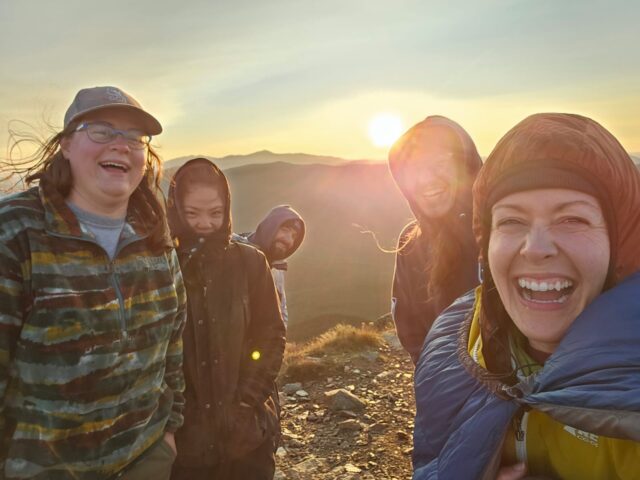
Photo by Kyrie Anderson
A special thanks to Mel Brown, Dante Giampaolo, and Rachel Hidding for their help with this project


